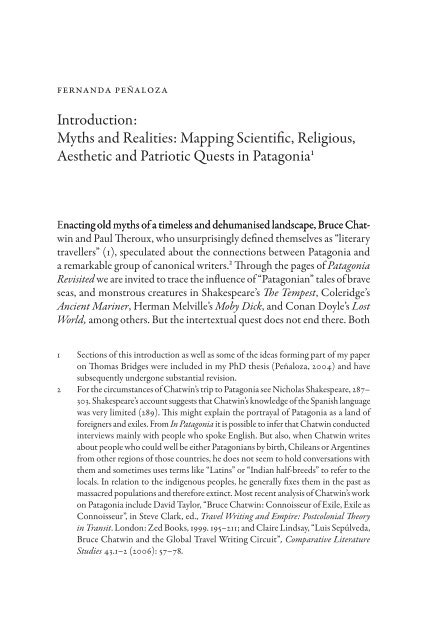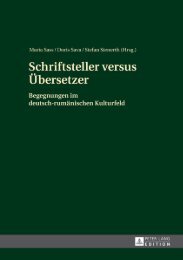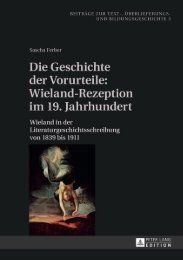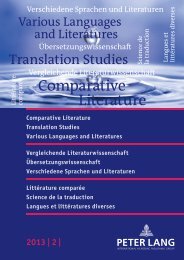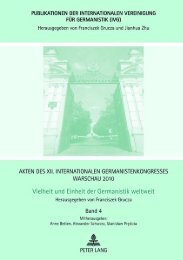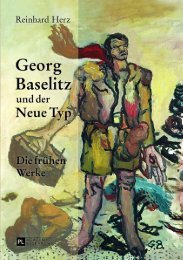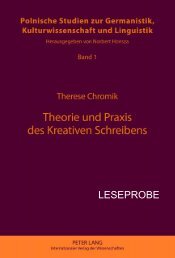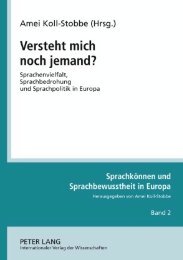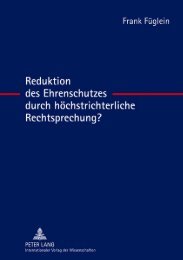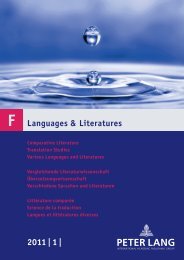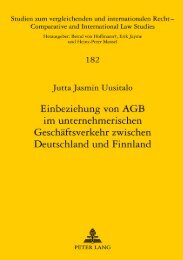Extract (PDF) - Peter Lang
Extract (PDF) - Peter Lang
Extract (PDF) - Peter Lang
You also want an ePaper? Increase the reach of your titles
YUMPU automatically turns print PDFs into web optimized ePapers that Google loves.
Fernanda Peñaloza<br />
Introduction:<br />
Myths and Realities: Mapping Scientific, Religious,<br />
Aesthetic and Patriotic Quests in Patagonia1<br />
Enacting nacting old myths of a timeless and dehumanised landscape, Bruce Chatwin<br />
and Paul Theroux, who unsurprisingly defined themselves as “literary<br />
travellers” (1), speculated about the connections between Patagonia and<br />
a remarkable group of canonical writers.2 Through the pages of Patagonia<br />
Revisited we are invited to trace the influence of “Patagonian” tales of brave<br />
seas, and monstrous creatures in Shakespeare’s The Tempest, Coleridge’s<br />
Ancient Mariner, Herman Melville’s Moby Dick, and Conan Doyle’s Lost<br />
World, among others. But the intertextual quest does not end there. Both<br />
1 Sections of this introduction as well as some of the ideas forming part of my paper<br />
on Thomas Bridges were included in my PhD thesis (Peñaloza, 2004) and have<br />
subsequently undergone substantial revision.<br />
2 For the circumstances of Chatwin’s trip to Patagonia see Nicholas Shakespeare, 287–<br />
303. Shakespeare’s account suggests that Chatwin’s knowledge of the Spanish language<br />
was very limited (289). This might explain the portrayal of Patagonia as a land of<br />
foreigners and exiles. From In Patagonia it is possible to infer that Chatwin conducted<br />
interviews mainly with people who spoke English. But also, when Chatwin writes<br />
about people who could well be either Patagonians by birth, Chileans or Argentines<br />
from other regions of those countries, he does not seem to hold conversations with<br />
them and sometimes uses terms like “Latins” or “Indian half-breeds” to refer to the<br />
locals. In relation to the indigenous peoples, he generally fixes them in the past as<br />
massacred populations and therefore extinct. Most recent analysis of Chatwin’s work<br />
on Patagonia include David Taylor, “Bruce Chatwin: Connoisseur of Exile, Exile as<br />
Connoisseur”, in Steve Clark, ed., Travel Writing and Empire: Postcolonial Theory<br />
in Transit. London: Zed Books, 1999. 195–211; and Claire Lindsay, “Luis Sepúlveda,<br />
Bruce Chatwin and the Global Travel Writing Circuit”, Comparative Literature<br />
Studies 43.1–2 (2006): 57–78.


